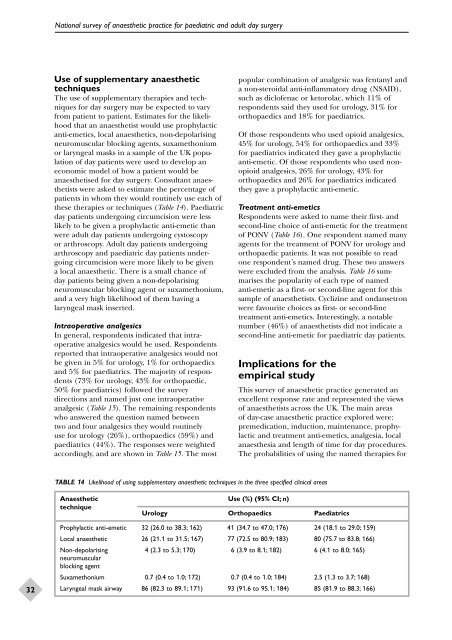Aanesthetic Agents for Day Surgery - NIHR Health Technology ...
Aanesthetic Agents for Day Surgery - NIHR Health Technology ...
Aanesthetic Agents for Day Surgery - NIHR Health Technology ...
Create successful ePaper yourself
Turn your PDF publications into a flip-book with our unique Google optimized e-Paper software.
32<br />
National survey of anaesthetic practice <strong>for</strong> paediatric and adult day surgery<br />
Use of supplementary anaesthetic<br />
techniques<br />
The use of supplementary therapies and techniques<br />
<strong>for</strong> day surgery may be expected to vary<br />
from patient to patient. Estimates <strong>for</strong> the likelihood<br />
that an anaesthetist would use prophylactic<br />
anti-emetics, local anaesthetics, non-depolarising<br />
neuromuscular blocking agents, suxamethonium<br />
or laryngeal masks in a sample of the UK population<br />
of day patients were used to develop an<br />
economic model of how a patient would be<br />
anaesthetised <strong>for</strong> day surgery. Consultant anaesthetists<br />
were asked to estimate the percentage of<br />
patients in whom they would routinely use each of<br />
these therapies or techniques (Table 14). Paediatric<br />
day patients undergoing circumcision were less<br />
likely to be given a prophylactic anti-emetic than<br />
were adult day patients undergoing cystoscopy<br />
or arthroscopy. Adult day patients undergoing<br />
arthroscopy and paediatric day patients undergoing<br />
circumcision were more likely to be given<br />
a local anaesthetic. There is a small chance of<br />
day patients being given a non-depolarising<br />
neuromuscular blocking agent or suxamethonium,<br />
and a very high likelihood of them having a<br />
laryngeal mask inserted.<br />
Intraoperative analgesics<br />
In general, respondents indicated that intraoperative<br />
analgesics would be used. Respondents<br />
reported that intraoperative analgesics would not<br />
be given in 5% <strong>for</strong> urology, 1% <strong>for</strong> orthopaedics<br />
and 5% <strong>for</strong> paediatrics. The majority of respondents<br />
(73% <strong>for</strong> urology, 43% <strong>for</strong> orthopaedic,<br />
50% <strong>for</strong> paediatrics) followed the survey<br />
directions and named just one intraoperative<br />
analgesic (Table 15). The remaining respondents<br />
who answered the question named between<br />
two and four analgesics they would routinely<br />
use <strong>for</strong> urology (26%), orthopaedics (59%) and<br />
paediatrics (44%). The responses were weighted<br />
accordingly, and are shown in Table 15. The most<br />
popular combination of analgesic was fentanyl and<br />
a non-steroidal anti-inflammatory drug (NSAID),<br />
such as diclofenac or ketorolac, which 11% of<br />
respondents said they used <strong>for</strong> urology, 31% <strong>for</strong><br />
orthopaedics and 18% <strong>for</strong> paediatrics.<br />
Of those respondents who used opioid analgesics,<br />
45% <strong>for</strong> urology, 54% <strong>for</strong> orthopaedics and 33%<br />
<strong>for</strong> paediatrics indicated they gave a prophylactic<br />
anti-emetic. Of those respondents who used nonopioid<br />
analgesics, 26% <strong>for</strong> urology, 43% <strong>for</strong><br />
orthopaedics and 26% <strong>for</strong> paediatrics indicated<br />
they gave a prophylactic anti-emetic.<br />
Treatment anti-emetics<br />
Respondents were asked to name their first- and<br />
second-line choice of anti-emetic <strong>for</strong> the treatment<br />
of PONV (Table 16). One respondent named many<br />
agents <strong>for</strong> the treatment of PONV <strong>for</strong> urology and<br />
orthopaedic patients. It was not possible to read<br />
one respondent’s named drug. These two answers<br />
were excluded from the analysis. Table 16 summarises<br />
the popularity of each type of named<br />
anti-emetic as a first- or second-line agent <strong>for</strong> this<br />
sample of anaesthetists. Cyclizine and ondansetron<br />
were favourite choices as first- or second-line<br />
treatment anti-emetics. Interestingly, a notable<br />
number (46%) of anaesthetists did not indicate a<br />
second-line anti-emetic <strong>for</strong> paediatric day patients.<br />
Implications <strong>for</strong> the<br />
empirical study<br />
This survey of anaesthetic practice generated an<br />
excellent response rate and represented the views<br />
of anaesthetists across the UK. The main areas<br />
of day-case anaesthetic practice explored were:<br />
premedication, induction, maintenance, prophylactic<br />
and treatment anti-emetics, analgesia, local<br />
anaesthesia and length of time <strong>for</strong> day procedures.<br />
The probabilities of using the named therapies <strong>for</strong><br />
TABLE 14 Likelihood of using supplementary anaesthetic techniques in the three specified clinical areas<br />
Anaesthetic Use (%) (95% CI; n)<br />
technique<br />
Urology Orthopaedics Paediatrics<br />
Prophylactic anti-emetic 32 (26.0 to 38.3; 162) 41 (34.7 to 47.0; 176) 24 (18.1 to 29.0; 159)<br />
Local anaesthetic 26 (21.1 to 31.5; 167) 77 (72.5 to 80.9; 183) 80 (75.7 to 83.8; 166)<br />
Non-depolarising<br />
neuromuscular<br />
blocking agent<br />
4 (2.3 to 5.3; 170) 6 (3.9 to 8.1; 182) 6 (4.1 to 8.0; 165)<br />
Suxamethonium 0.7 (0.4 to 1.0; 172) 0.7 (0.4 to 1.0; 184) 2.5 (1.3 to 3.7; 168)<br />
Laryngeal mask airway 86 (82.3 to 89.1; 171) 93 (91.6 to 95.1; 184) 85 (81.9 to 88.3; 166)
















